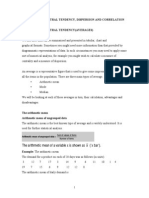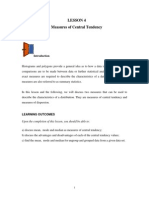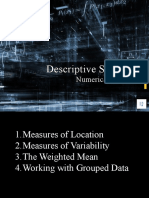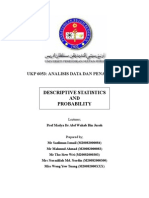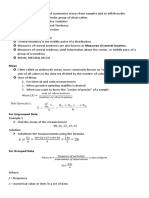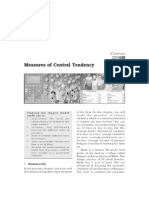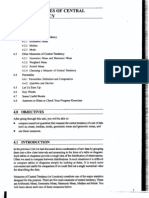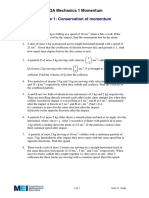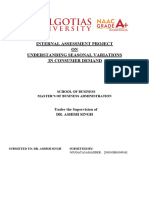Mean, Median & Mode PDF
Mean, Median & Mode PDF
Uploaded by
wolfretonmathsCopyright:
Available Formats
Mean, Median & Mode PDF
Mean, Median & Mode PDF
Uploaded by
wolfretonmathsOriginal Title
Copyright
Available Formats
Share this document
Did you find this document useful?
Is this content inappropriate?
Copyright:
Available Formats
Mean, Median & Mode PDF
Mean, Median & Mode PDF
Uploaded by
wolfretonmathsCopyright:
Available Formats
AQA Statistics 1 Numerical measures
1 of 11 13/11/13 MEI
Section 1: Mean, median and mode
Notes and Examples
These notes have sub-sections on:
Measures of central tendency
Comparison of measures of central tendency
Finding measures of central tendency from frequency distributions
Estimating the median from grouped data
Estimating the mean from grouped data
Measures of central tendency
There are three of these which are commonly used:
- the median
- the mode
- the mean
You need to be able to calculate these for both discrete and continuous data.
You also need to appreciate the different properties of each of these
measures.
The median
When data is arranged in order, the median is the item of data in the middle.
However, when there is an even number of data, the middle one lies between
two values, and we use the mean of these two values for the median.
For example, this dataset has 9 items:
1 1 3 4 6 7 7 9 10
If another item of data is added to give 10 items, the middle items are the 5
th
and 6
th
:
1 1 3 4 6 7 7 9 10 12
so the median is the mean average of the 5
th
and 6
th
items, i.e.
6 7
6.5
2
.
The mode
The mode is the most common or frequent item of data; in other words the
item with the highest frequency.
So for the data set {6, 7, 8, 8, 9}
the mode is 8 as this appears twice.
There are 4 data items below the
5
th
and 4 items above; so the
middle item is the 5
th
, which is 6.
AQA S1 Numerical measures 1 Notes & Examples
2 of 11 13/11/13 MEI
is the Greek letter sigma and stands
for the sum of. The whole
expression is saying: The mean ( x )
is equal to the sum of all the data
items (X
i
for i = 1 to n) divided by the
number of data items (n).
There may be more than one mode, if more than one item has the highest
frequency.
Example 1
For the following data:
1.65 1.65 1.66 1.67 1.68 1.70 1.70 1.71 1.73 1.73
1.77 1.78 1.79 1.82 1.82 1.82 1.85 1.85 1.88 1.90
find
(i) the median (ii) the mode
Solution
(i) Counting from the lowest item (1.65), the 10th is 1.73 and the 11th is 1.77.
The median is therefore
1.73 1.77
1.75
2
.
(ii) No item appears more than twice except for 1.82 which appears three times.
The mode is 1.82.
The mean
When people talk about the average, it is usually the mean they mean! This is
the sum of the data divided by the number of items of data.
We can express this using mathematical notation as follows:
For the data set x
1
, x
2
, x
3
, x
4
, x
n
,
Example 2 shows a very simple calculation set out using this formal notation.
Example 2
Find the mean of the data set {6, 7, 8, 8, 9}.
Solution
x
1
= 6, x
2
= 7, x
3
= 8, x
4
= 8, x
5
= 9 , n = 5
5
1 1 2 3 4 5
6 7 8 8 9
7.6
5 5 5
i
i
x
x x x x x
x
1
1
n
i
i
x x
n
x denotes the
mean value of x
AQA S1 Numerical measures 1 Notes & Examples
3 of 11 13/11/13 MEI
Comparison of measures of central tendency (averages)
The mean includes all the data in the average, and takes account of the
numerical value of all the data. So exceptionally large or small items of
data can have a large effect on the mean it is susceptible to outliers.
The median is less sensitive to high and low values (outliers), as it is
simply the middle value in order of size. If the numerical values of each of
the items of data is relevant to the average, then the mean is a better
measure; if not, use the median.
The mode picks out the commonest data item. This is only significant if
there are relatively high frequencies involved. It takes no account at all of
the numerical values of the data.
Suppose you are negotiating a salary increase for employees at a small firm.
The salaries are currently as follows:
6000, 12000, 14000, 14000, 15000, 15000, 15000, 15000,
16000, 16000, 18000, 18000, 18000, 20000, 100000
The mean salary is 20800
The median salary is 15000
The modal salary is also 15000
Which is the most appropriate measure?
If you were the managing director, you might quote the mean of 20800, but
of the current employees she is the only one who earns more than this
amount.
If you were the union representative, you would quote the median or the mode
(15000), as these give the lowest averages. This is certainly more typical of
the majority of workers.
There is no right answer to the appropriate average to take it depends on
the purpose to which it is put. However, it is clear that:
The mean takes account of the numerical value of all the data, and is
higher due to the effect of the 100000 salary, which is an outlier.
The median and mode are not affected by the outliers (100000 and
6000)
The 6000 is a part-time worker
who works only two days a week
The 100000 is the
managing director
AQA S1 Numerical measures 1 Notes & Examples
4 of 11 13/11/13 MEI
Example 3
Shanice receives the following marks for her end-of-term exams:
Subject Mark (%)
Maths 30
English 80
Physics 45
Chemistry 47
French 47
History 50
Biology 46
Religious Education 55
Calculate the mean, median and mode. Comment on which is the most appropriate
measure of average for this data.
Solution
The mean =
30 80 45 47 47 50 46 55
50
8
In numerical order, the results are: 30, 45, 46, 47, 47, 50, 55, 80
The median is therefore 47.
The mode is 47, as there are two of these and only one each of the other marks.
The mode is not suitable there is no significance in getting two scores of 47.
The median or the mean could be used. The mean is higher since it takes more
account of the high English result. The median is perhaps the most representative, and
she got 4 scores in the range 45-47; but Shanice would no doubt use the mean to make
more of her good English result!
Finding measures of central tendency from frequency
distributions
When data are given in the form of a frequency table, the methods for finding
measures of central tendency have to be adapted slightly.
The mean
x f
1 3
2 5
3 2
4 3
5 4
6 3
Total 20
AQA S1 Numerical measures 1 Notes & Examples
5 of 11 13/11/13 MEI
The mean of the data shown in the frequency table above can be written as
1 1 1 2 2 2 2 2 3 3 4 4 4 5 5 5 5 6 6 6 69
3.45
20 20
x
An alternative way of writing this is
3 5 2 3 4 1 2 3 4 5 6 6 3
3 5 2
9
3.4
2 3
5
0 4 3
x
This can be expressed more formally as
6
1
6
1
i i
i
i
i
f x
x
f
It is helpful to add another column to the frequency table, for the product fx.
x f fx
1 3 3
2 5 10
3 2 6
4 3 12
5 4 20
6 3 18
Total
20 f
69 fx
Then you can simply add up the two columns and use the totals to calculate
the mean.
69
3.45
20
fx
x
f
In general, when the data is given using frequencies, the formula for the mean
is:
1
1
n
i i
i
n
i
i
f x
x
f
The median
When you want to find the median of a data set presented in a frequency
table, one useful point is that the data is already ordered.
Each value of x is multiplied by its frequency,
and then the results are added together.
The frequencies are added to find the total
number of data items
AQA S1 Numerical measures 1 Notes & Examples
6 of 11 13/11/13 MEI
x f
1 3
2 5
3 2
4 3
5 4
6 3
Total 20
For this data set, there are 20 data items, so the median is the mean of the
10
th
and 11
th
items.
For this small set of data, it is easy to see that the 10
th
data item is 3 and the
11
th
is 4. The median is therefore 3.5.
However, for a larger set of data it may be more difficult to identify the middle
item or items. One way to make this a little easier is to use a cumulative
frequency table.
x f Cum. freq.
1 3 3
2 5 8
3 2 10
4 3 13
5 4 17
6 3 20
The final value of the cumulative frequency (in this case 20) tells you the total
of the frequencies. The cumulative frequencies show that the 10
th
item is 3
and the 11
th
item is 4. So the median is 3.5.
The mode
Identifying the mode is easy when data are given in a frequency table.
x f
1 3
2 5
3 2
4 3
5 4
6 3
Total 20
The third column gives the
cumulative frequency. This is
the total of the frequencies so far.
You can find each cumulative
frequency by adding each frequency
to the previous cumulative frequency.
E.g., for x = 4, the cumulative
frequency is 10 + 3 = 13.
The highest frequency is for
x = 2. So the mode is 2.
AQA S1 Numerical measures 1 Notes & Examples
7 of 11 13/11/13 MEI
Example 4
For the following set of data
x f
22 5
23 17
24 23
25 35
26 12
Total 92
find the values of
(i) the mean (ii) the median (iii) the mode
Solution
(i)
22 5 23 17 24 23 25 35 26 12
5 17 23 35 12
2240
24.3 (3 s.f.)
92
x
The mean = 24.3 (3 s.f.)
(ii) Make a cumulative frequency table:
x f cf
22 5 5
23 17 22
24 23 45
25 35 80
26 12 92
Since there are 92 data items, the median is the average of the 46
th
and 47
th
items.
There are 45 items of 24 or less, and 80 items of 25 or less.
So clearly the 46
th
and 47
th
items are both 25.
The median is 25.
(iii) The highest frequency is for x = 25.
The mode is 25.
Estimating the median from grouped data
If data is only available as a grouped frequency distribution, then it is not
possible to find the exact values of the median.
However, it is possible to estimate values for these. The work below shows
how this is done, although in practice you dont need to actually draw the
diagram, unless you find it helps you.
AQA S1 Numerical measures 1 Notes & Examples
8 of 11 13/11/13 MEI
Suppose, for example, that you want to estimate the median of the data set
shown below.
There are 31 data items, so you need to find the 16
th
data item.
It is helpful to add the cumulative frequencies to this table. This shows clearly
that the 16
th
data item lies in the class interval 40 50 w , and it is the 8
th
item in this class interval (which contains 11 items).
The example below illustrates this approach.
40
50
Cumulative frequency
w
8
16
19
Weight w, (kg) Frequency
30 w < 35
2
35 w < 40
6
40 w < 50
10
50 w < 60
8
60 w < 65
5
over 65 0
Weight (kg) Frequency Weight
Cumulative
frequency
w < 30 0
30 w < 35
2 w < 35 2
35 w < 40
6 w < 40 8
40 w < 50
11 w < 50 19
50 w < 60
7 w < 60 26
60 w < 65
5 w < 65 31
The 16
th
item is
8
11
along the class
interval. So you need to find
8
11
of the
class width, i.e.
8
11
10 7.27 . This tells
you how far along the class interval the
8
th
item lies.
So its position is 40 + 7.27 = 47.27.
AQA S1 Numerical measures 1 Notes & Examples
9 of 11 13/11/13 MEI
Example 5
Estimate the median of the following dataset, which gives the mass of 100 eggs.
Solution
The median is the 50
th
data item. This lies in the 55 m < 60 class interval.
The median is the 16
th
data item out of the 22 data items in that class.
Median
16
55 5 58.6
22
grams.
Note that for a large data set like the one in Example 5, you can simply take
the median as being the
2
n
th item, rather than halfway between the nth item
and the (n +1)th item.
An alternative way of estimating the median for grouped data is to draw a
cumulative frequency curve. You can then read off the value for the
2
n
th item,
as an estimate for the median.
Note: earlier you used the cumulative frequency to help find the median of
small, discrete data sets. The cumulative frequency for a particular value was
defined as the number of data items less than or equal to that value. For the
data above, however, the cumulative frequencies are given as the frequencies
for m < 40, m < 50 and so on. Since the data is continuous, there is no
Mass, m (g) Frequency
40 m < 45
4
45 m < 50
15
50 m < 55
15
55 m < 60
22
60 m < 65
17
65 m < 70
16
70 m < 75
11
75 m < 80
0
Mass, m (g) Frequency Mass Cumulative
frequency
m < 40 0
40 m < 45
4 m < 45 4
45 m < 50
15 m < 50 19
50 m < 55
15 m < 55 34
55 m < 60
22 m < 60 56
60 m < 65
17 m < 65 73
65 m < 70
16 m < 70 89
70 m < 75
11 m < 75 100
AQA S1 Numerical measures 1 Notes & Examples
10 of 11 13/11/13 MEI
distinction between m < 40 and m 40, so there is no problem with this.
However, when you are dealing with discrete data, you must ensure that
cumulative frequencies relate to less than or equal to a value.
The cumulative frequency curve for the data in Example 5 is drawn below:
From the curve, the median is estimated to be 58.
Estimating the mean from grouped data
When the data is grouped into classes, you can still estimate the mean by
using the midpoint of the classes (the mid-interval value). This means that you
assume that all the values in each class interval are equally spaced about the
mid-point.
You can show most of the calculations in a table, as shown in the following
example.
40
50 60 70
20
40
60
80
100
c.f.
mass (kg)
50 of the eggs lie
below the median,
shown by the red line.
AQA S1 Numerical measures 1 Notes & Examples
11 of 11 13/11/13 MEI
Example 6
Estimate the mean weight for the following data:
Weight, w, (kg) Frequency
50 w < 60
3
60 w < 70
5
70 w < 80
7
80 w < 90
3
90 w < 100
2
Total 20
Solution
Weight, w, (kg) Mid-interval
value, x
Frequency, f fx
50 w < 60
55 3 165
60 w < 70
65 5 325
70 w < 80
75 7 525
80 w < 90
85 3 255
90 w < 100
95 2 190
20 f
1460 fx
1460
73
20
fx
x
f
The mean weight is estimated to be 73 kg.
To find mid-interval values, you need to think carefully about the upper and
lower bounds of each interval. In the example above, it is clear what these
bounds are. However, if the intervals had been expressed as 50 59, 60 69
and so on, then it is clear that the original weights had been rounded to the
nearest kilogram, and the intervals were actually 49.5 w < 59.5,
59.5 w < 69.5, etc. So in that case the mid-interval values would be 54.5, 64.5
and so on.
The mid-interval value is the
mean of the upper and lower
bound of the weight.
You might also like
- Using Parametric Equations - Solutions PDFDocument4 pagesUsing Parametric Equations - Solutions PDFwolfretonmathsNo ratings yet
- Practical Engineering, Process, and Reliability StatisticsFrom EverandPractical Engineering, Process, and Reliability StatisticsNo ratings yet
- Connected Particles Exercise PDFDocument2 pagesConnected Particles Exercise PDFwolfretonmaths100% (1)
- Using Parametric Equations Exercise PDFDocument1 pageUsing Parametric Equations Exercise PDFwolfretonmaths0% (2)
- Chapter 3 - Describing Comparing DataDocument21 pagesChapter 3 - Describing Comparing DataPedro ChocoNo ratings yet
- Using Graphs - Solutions PDFDocument5 pagesUsing Graphs - Solutions PDFwolfretonmaths100% (1)
- Connected Particles - Solutions PDFDocument6 pagesConnected Particles - Solutions PDFwolfretonmaths67% (3)
- Art Integrated Project MathsDocument13 pagesArt Integrated Project MathsB.M.V.Aditya XA100% (2)
- CHAPTER 1 Descriptive StatisticsDocument5 pagesCHAPTER 1 Descriptive StatisticsOana Şi CosminNo ratings yet
- Lesson 3 EdtechDocument8 pagesLesson 3 Edtechapi-268563289No ratings yet
- StatisticsDocument211 pagesStatisticsHasan Hüseyin Çakır100% (6)
- Measures of Central Tendency Dispersion and CorrelationDocument27 pagesMeasures of Central Tendency Dispersion and CorrelationFranco Martin Mutiso100% (1)
- المحاضرة رقم 3Document44 pagesالمحاضرة رقم 3د.م. حيدر كاظم زغير الجبوريNo ratings yet
- BiostatisticsDocument23 pagesBiostatisticsHansa BorichaNo ratings yet
- Lesson 4 Measure of Central TendencyDocument20 pagesLesson 4 Measure of Central Tendencyrahmanzaini100% (1)
- Chapter 3 Numerical Descriptive Measures: 3.1 Measures of Central Tendency For Ungrouped DataDocument14 pagesChapter 3 Numerical Descriptive Measures: 3.1 Measures of Central Tendency For Ungrouped DataKhay OngNo ratings yet
- Chapter 4 Descriptive MeasuresDocument17 pagesChapter 4 Descriptive MeasuresRobel MetikuNo ratings yet
- Chapter 3 DispersionDocument12 pagesChapter 3 DispersionElan JohnsonNo ratings yet
- Unit4 Fundamental Stat Maths2 (D)Document28 pagesUnit4 Fundamental Stat Maths2 (D)Azizul AnwarNo ratings yet
- Chapter 3 Measure of Central TendencyDocument48 pagesChapter 3 Measure of Central Tendencymonicabalamurugan27No ratings yet
- Statistical AnalysisDocument15 pagesStatistical AnalysisHello HelloNo ratings yet
- CHAPTER THREEDocument24 pagesCHAPTER THREEHabtamu SntayhuNo ratings yet
- Mean, Median and Mode 1 PDFDocument16 pagesMean, Median and Mode 1 PDFMbalieZee0% (1)
- Basic StatisticsDocument73 pagesBasic Statisticsartee_aggrawal4312100% (8)
- Mean Median ModeDocument12 pagesMean Median ModeSriram Mohan100% (3)
- Mt271 Statistics For Non-Majors (3 Units) : Lecture 2: Graphic Presentation of DataDocument15 pagesMt271 Statistics For Non-Majors (3 Units) : Lecture 2: Graphic Presentation of DataLotead JohnNo ratings yet
- ASSIGNMEN4Document15 pagesASSIGNMEN4Harshita Sharma100% (1)
- Measure of Central Tendency in StatisticsDocument16 pagesMeasure of Central Tendency in StatisticsAnshu SinghNo ratings yet
- Measure of Central Tendency: Measure of Location: GoalsDocument7 pagesMeasure of Central Tendency: Measure of Location: GoalsDebashish MahapatraNo ratings yet
- Unit 3 - Measures of Central TendencyDocument15 pagesUnit 3 - Measures of Central TendencyPrevenaManiamNo ratings yet
- Measures of Spread PDFDocument11 pagesMeasures of Spread PDFwolfretonmathsNo ratings yet
- 02 Descriptive StatisticsDocument30 pages02 Descriptive StatisticsWahyu AdilNo ratings yet
- Engineering Probability and StatisticsDocument42 pagesEngineering Probability and StatisticsKevin RamosNo ratings yet
- Describing Data: Centre Mean Is The Technical Term For What Most People Call An Average. in Statistics, "Average"Document4 pagesDescribing Data: Centre Mean Is The Technical Term For What Most People Call An Average. in Statistics, "Average"Shane LambertNo ratings yet
- Module 5Document74 pagesModule 5Jessa Bell Cuales0% (1)
- Exercise Lesson 4,5,6Document23 pagesExercise Lesson 4,5,6mahmud_aNo ratings yet
- Summarising and Analysing DataDocument36 pagesSummarising and Analysing DataRomail QaziNo ratings yet
- 1 - Descriptive Statistics Data: Frequency DistributionDocument57 pages1 - Descriptive Statistics Data: Frequency DistributionspecialityNo ratings yet
- Descriptive StatisticsDocument7 pagesDescriptive StatisticsShane LiwagNo ratings yet
- Ken Black QA 5th Chapter 3 SolutionDocument47 pagesKen Black QA 5th Chapter 3 SolutionRushabh VoraNo ratings yet
- 2 Mean Median Mode VarianceDocument29 pages2 Mean Median Mode VarianceBonita Mdoda-ArmstrongNo ratings yet
- Measures of Central TendencyDocument49 pagesMeasures of Central TendencyCecile Cataga BalingcongNo ratings yet
- Measures of Central TendencyDocument24 pagesMeasures of Central TendencyJoshua RaninNo ratings yet
- 3 Measures of Central Tendency (Mean, Median)Document32 pages3 Measures of Central Tendency (Mean, Median)Mohamed FathyNo ratings yet
- 3.0 Measures of Central Tendency.Document12 pages3.0 Measures of Central Tendency.kennedy majakaNo ratings yet
- 5Document16 pages5Sanya BajajNo ratings yet
- Statistics Grade 12Document24 pagesStatistics Grade 12Reitumetse MolefeNo ratings yet
- CH 03Document45 pagesCH 03Ansari MustakNo ratings yet
- Various Measures of Central TendencyDocument17 pagesVarious Measures of Central TendencypurivikrantNo ratings yet
- Chap1 Lesson 2Document10 pagesChap1 Lesson 2Jun PontiverosNo ratings yet
- Bus173 Chap03Document42 pagesBus173 Chap03KaziRafiNo ratings yet
- Statistics Part 1 and 2Document53 pagesStatistics Part 1 and 2ledwabakarabo23No ratings yet
- 0 - Last Module Math in The Modern WorldDocument20 pages0 - Last Module Math in The Modern WorldCristy Lansangan Mejia50% (2)
- Stat HandoutDocument7 pagesStat HandoutJenrick DimayugaNo ratings yet
- Study of Averages FinalDocument111 pagesStudy of Averages FinalVishal KumarNo ratings yet
- Unit 20 - Central Tendency and Dispersion (Student)Document13 pagesUnit 20 - Central Tendency and Dispersion (Student)Suresh MgNo ratings yet
- Meharaj Khan (BS)Document7 pagesMeharaj Khan (BS)RebelNo ratings yet
- 1 Measures of Central TendencyDocument35 pages1 Measures of Central TendencyPawan PatilNo ratings yet
- Stat Measures of Central TendencyDocument9 pagesStat Measures of Central TendencyJosh DavidNo ratings yet
- Measures of Central Tendency and DispersionDocument9 pagesMeasures of Central Tendency and DispersionAlduin04No ratings yet
- Iim IprobabilityDocument43 pagesIim IprobabilityMarx ChryzNo ratings yet
- BS Unit 2Document37 pagesBS Unit 2Sneha DavisNo ratings yet
- MeanDocument7 pagesMeanSidi OmarNo ratings yet
- Measures of Central TendencyDocument40 pagesMeasures of Central TendencyAnagha AnuNo ratings yet
- Introduction To Business Statistics Through R Software: SoftwareFrom EverandIntroduction To Business Statistics Through R Software: SoftwareNo ratings yet
- Newton's Laws of Motion Exercise PDFDocument2 pagesNewton's Laws of Motion Exercise PDFwolfretonmathsNo ratings yet
- Using Vectors Exercise PDFDocument2 pagesUsing Vectors Exercise PDFwolfretonmathsNo ratings yet
- Using Graphs Exercise PDFDocument4 pagesUsing Graphs Exercise PDFwolfretonmathsNo ratings yet
- Projectile Motion - Solutions PDFDocument6 pagesProjectile Motion - Solutions PDFwolfretonmathsNo ratings yet
- Projectile Motion Exercise PDFDocument2 pagesProjectile Motion Exercise PDFwolfretonmaths100% (4)
- Forces & Equilibrium Exercise PDFDocument2 pagesForces & Equilibrium Exercise PDFwolfretonmathsNo ratings yet
- Constant Acceleration Exercise PDFDocument2 pagesConstant Acceleration Exercise PDFwolfretonmathsNo ratings yet
- Newton's Laws of Motion - Solutions PDFDocument6 pagesNewton's Laws of Motion - Solutions PDFwolfretonmathsNo ratings yet
- Constant Acceleration - Solutions PDFDocument6 pagesConstant Acceleration - Solutions PDFwolfretonmathsNo ratings yet
- Friction Exercise PDFDocument1 pageFriction Exercise PDFwolfretonmathsNo ratings yet
- Projectile Motion CPDocument1 pageProjectile Motion CPwolfretonmathsNo ratings yet
- Conservation of Momentum CPDocument1 pageConservation of Momentum CPwolfretonmathsNo ratings yet
- Using GraphsDocument9 pagesUsing GraphswolfretonmathsNo ratings yet
- Conservation of Momentum Exercise PDFDocument1 pageConservation of Momentum Exercise PDFwolfretonmathsNo ratings yet
- Projectile MotionDocument10 pagesProjectile MotionwolfretonmathsNo ratings yet
- Conservation of MomentumDocument2 pagesConservation of MomentumwolfretonmathsNo ratings yet
- The Binomial ExpansionDocument6 pagesThe Binomial Expansionwolfretonmaths100% (1)
- Using Partial Fractions in Integration Exercise PDFDocument1 pageUsing Partial Fractions in Integration Exercise PDFwolfretonmathsNo ratings yet
- Vectors in Two & Three Dimensions Exercise PDFDocument2 pagesVectors in Two & Three Dimensions Exercise PDFwolfretonmathsNo ratings yet
- SRM Math - Fourth QuarterDocument48 pagesSRM Math - Fourth QuarterELJON MINDORONo ratings yet
- Note Statistics 2021 Part 3Document22 pagesNote Statistics 2021 Part 3amira qistinaNo ratings yet
- An Assignment Quantinative MethodDocument12 pagesAn Assignment Quantinative Methodfuck u bitchNo ratings yet
- Unit 05 - 08Document39 pagesUnit 05 - 08Nigussie WenNo ratings yet
- Unit 8. Data AnalysisDocument69 pagesUnit 8. Data Analysistebebe solomonNo ratings yet
- Math7 Q4 Mod6 Analysis InterpretationofData v3Document29 pagesMath7 Q4 Mod6 Analysis InterpretationofData v3Rainman InsanityNo ratings yet
- Data Analysis Stats 2Document13 pagesData Analysis Stats 2Sagar GichkiNo ratings yet
- Measures of Central TendencyDocument4 pagesMeasures of Central TendencyMiraluna Pilones NuñezNo ratings yet
- Quantitative Reasoning - LLB-II (1)Document48 pagesQuantitative Reasoning - LLB-II (1)abduldaim387No ratings yet
- 4.1 - Interpreting StatisticsDocument3 pages4.1 - Interpreting Statisticskctgkxckz2No ratings yet
- Statiscal Method Using RDocument150 pagesStatiscal Method Using R20BCS2512 Yashendra RajputNo ratings yet
- Norms and Test StandardizationDocument31 pagesNorms and Test StandardizationHajra KhanNo ratings yet
- Ia-2 Business StatsDocument21 pagesIa-2 Business StatsSougata Samadder100% (1)
- SPSS RecordDocument35 pagesSPSS RecordKV N P VARUN KUMARNo ratings yet
- Week 4 Measures of Central Tendency For Ungrouped DataDocument27 pagesWeek 4 Measures of Central Tendency For Ungrouped DataChrista LenzNo ratings yet
- Social Research and Social Work Research: Unit 1Document32 pagesSocial Research and Social Work Research: Unit 1Prudhvi KNo ratings yet
- S. S. Jain Subodh P.G. Autonomous College: Scheme of Examination & Detailed Course StructureDocument28 pagesS. S. Jain Subodh P.G. Autonomous College: Scheme of Examination & Detailed Course StructureVaibhav AroraNo ratings yet
- Mean Mode RangeDocument16 pagesMean Mode RangePraise NehumambiNo ratings yet
- Final Exam Adv Stat Submission January 8 2023Document8 pagesFinal Exam Adv Stat Submission January 8 2023Jerwin SamsonNo ratings yet
- SSI Securities CorporationDocument10 pagesSSI Securities Corporationcamthuy1611_41546015No ratings yet
- Descriptive Statistics BCA FinalDocument62 pagesDescriptive Statistics BCA FinalNikit Kumar PaudelNo ratings yet
- 8 Central TendencyDocument32 pages8 Central Tendencybee100% (1)
- Activity 4 - Central TendencyDocument2 pagesActivity 4 - Central TendencyCatherine GuzmanNo ratings yet
- Activity and Module 2 Statistics and Probability - G11Document4 pagesActivity and Module 2 Statistics and Probability - G11rakistabanda6No ratings yet
- Chapter 3 Mean, Median, ModeDocument29 pagesChapter 3 Mean, Median, ModeNinad AbhyankarNo ratings yet
- FMIIIDocument144 pagesFMIIIJunela RodelasNo ratings yet
- Measure of VariabilityDocument3 pagesMeasure of VariabilityZari NovelaNo ratings yet
- Module 3. - Measures of Central TendencyDocument21 pagesModule 3. - Measures of Central TendencyMarvin Yebes ArceNo ratings yet
- MODULE 3 - Central TendencyDocument11 pagesMODULE 3 - Central TendencyRaine TaclaNo ratings yet











